Zhengzhe Liu
OPA-Pack: Object-Property-Aware Robotic Bin Packing
May 19, 2025Abstract:Robotic bin packing aids in a wide range of real-world scenarios such as e-commerce and warehouses. Yet, existing works focus mainly on considering the shape of objects to optimize packing compactness and neglect object properties such as fragility, edibility, and chemistry that humans typically consider when packing objects. This paper presents OPA-Pack (Object-Property-Aware Packing framework), the first framework that equips the robot with object property considerations in planning the object packing. Technical-wise, we develop a novel object property recognition scheme with retrieval-augmented generation and chain-of-thought reasoning, and build a dataset with object property annotations for 1,032 everyday objects. Also, we formulate OPA-Net, aiming to jointly separate incompatible object pairs and reduce pressure on fragile objects, while compacting the packing. Further, OPA-Net consists of a property embedding layer to encode the property of candidate objects to be packed, together with a fragility heightmap and an avoidance heightmap to keep track of the packed objects. Then, we design a reward function and adopt a deep Q-learning scheme to train OPA-Net. Experimental results manifest that OPA-Pack greatly improves the accuracy of separating incompatible object pairs (from 52% to 95%) and largely reduces pressure on fragile objects (by 29.4%), while maintaining good packing compactness. Besides, we demonstrate the effectiveness of OPA-Pack on a real packing platform, showcasing its practicality in real-world scenarios.
Rethinking End-to-End 2D to 3D Scene Segmentation in Gaussian Splatting
Mar 18, 2025Abstract:Lifting multi-view 2D instance segmentation to a radiance field has proven to be effective to enhance 3D understanding. Existing methods rely on direct matching for end-to-end lifting, yielding inferior results; or employ a two-stage solution constrained by complex pre- or post-processing. In this work, we design a new end-to-end object-aware lifting approach, named Unified-Lift that provides accurate 3D segmentation based on the 3D Gaussian representation. To start, we augment each Gaussian point with an additional Gaussian-level feature learned using a contrastive loss to encode instance information. Importantly, we introduce a learnable object-level codebook to account for individual objects in the scene for an explicit object-level understanding and associate the encoded object-level features with the Gaussian-level point features for segmentation predictions. While promising, achieving effective codebook learning is non-trivial and a naive solution leads to degraded performance. Therefore, we formulate the association learning module and the noisy label filtering module for effective and robust codebook learning. We conduct experiments on three benchmarks: LERF-Masked, Replica, and Messy Rooms datasets. Both qualitative and quantitative results manifest that our Unified-Lift clearly outperforms existing methods in terms of segmentation quality and time efficiency. The code is publicly available at \href{https://github.com/Runsong123/Unified-Lift}{https://github.com/Runsong123/Unified-Lift}.
WonderVerse: Extendable 3D Scene Generation with Video Generative Models
Mar 13, 2025Abstract:We introduce \textit{WonderVerse}, a simple but effective framework for generating extendable 3D scenes. Unlike existing methods that rely on iterative depth estimation and image inpainting, often leading to geometric distortions and inconsistencies, WonderVerse leverages the powerful world-level priors embedded within video generative foundation models to create highly immersive and geometrically coherent 3D environments. Furthermore, we propose a new technique for controllable 3D scene extension to substantially increase the scale of the generated environments. Besides, we introduce a novel abnormal sequence detection module that utilizes camera trajectory to address geometric inconsistency in the generated videos. Finally, WonderVerse is compatible with various 3D reconstruction methods, allowing both efficient and high-quality generation. Extensive experiments on 3D scene generation demonstrate that our WonderVerse, with an elegant and simple pipeline, delivers extendable and highly-realistic 3D scenes, markedly outperforming existing works that rely on more complex architectures.
What Matters in Detecting AI-Generated Videos like Sora?
Jun 27, 2024Abstract:Recent advancements in diffusion-based video generation have showcased remarkable results, yet the gap between synthetic and real-world videos remains under-explored. In this study, we examine this gap from three fundamental perspectives: appearance, motion, and geometry, comparing real-world videos with those generated by a state-of-the-art AI model, Stable Video Diffusion. To achieve this, we train three classifiers using 3D convolutional networks, each targeting distinct aspects: vision foundation model features for appearance, optical flow for motion, and monocular depth for geometry. Each classifier exhibits strong performance in fake video detection, both qualitatively and quantitatively. This indicates that AI-generated videos are still easily detectable, and a significant gap between real and fake videos persists. Furthermore, utilizing the Grad-CAM, we pinpoint systematic failures of AI-generated videos in appearance, motion, and geometry. Finally, we propose an Ensemble-of-Experts model that integrates appearance, optical flow, and depth information for fake video detection, resulting in enhanced robustness and generalization ability. Our model is capable of detecting videos generated by Sora with high accuracy, even without exposure to any Sora videos during training. This suggests that the gap between real and fake videos can be generalized across various video generative models. Project page: https://justin-crchang.github.io/3DCNNDetection.github.io/
Object-level Scene Deocclusion
Jun 11, 2024
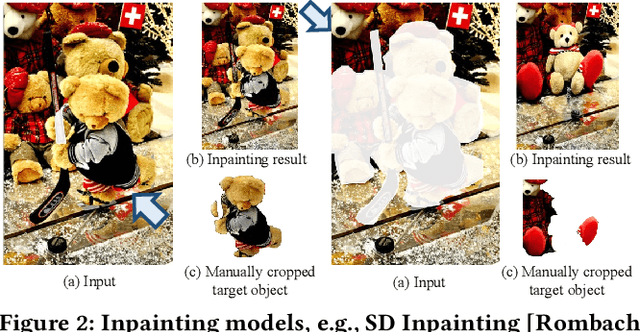


Abstract:Deoccluding the hidden portions of objects in a scene is a formidable task, particularly when addressing real-world scenes. In this paper, we present a new self-supervised PArallel visible-to-COmplete diffusion framework, named PACO, a foundation model for object-level scene deocclusion. Leveraging the rich prior of pre-trained models, we first design the parallel variational autoencoder, which produces a full-view feature map that simultaneously encodes multiple complete objects, and the visible-to-complete latent generator, which learns to implicitly predict the full-view feature map from partial-view feature map and text prompts extracted from the incomplete objects in the input image. To train PACO, we create a large-scale dataset with 500k samples to enable self-supervised learning, avoiding tedious annotations of the amodal masks and occluded regions. At inference, we devise a layer-wise deocclusion strategy to improve efficiency while maintaining the deocclusion quality. Extensive experiments on COCOA and various real-world scenes demonstrate the superior capability of PACO for scene deocclusion, surpassing the state of the arts by a large margin. Our method can also be extended to cross-domain scenes and novel categories that are not covered by the training set. Further, we demonstrate the deocclusion applicability of PACO in single-view 3D scene reconstruction and object recomposition.
CNS-Edit: 3D Shape Editing via Coupled Neural Shape Optimization
Feb 04, 2024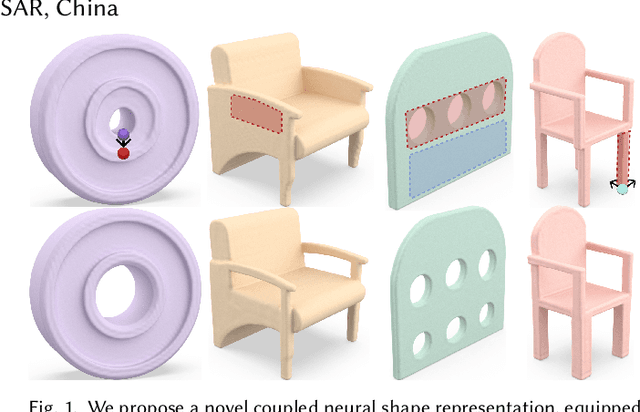

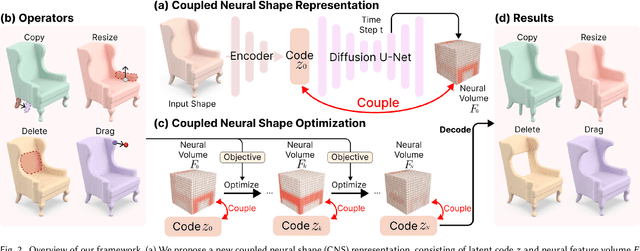

Abstract:This paper introduces a new approach based on a coupled representation and a neural volume optimization to implicitly perform 3D shape editing in latent space. This work has three innovations. First, we design the coupled neural shape (CNS) representation for supporting 3D shape editing. This representation includes a latent code, which captures high-level global semantics of the shape, and a 3D neural feature volume, which provides a spatial context to associate with the local shape changes given by the editing. Second, we formulate the coupled neural shape optimization procedure to co-optimize the two coupled components in the representation subject to the editing operation. Last, we offer various 3D shape editing operators, i.e., copy, resize, delete, and drag, and derive each into an objective for guiding the CNS optimization, such that we can iteratively co-optimize the latent code and neural feature volume to match the editing target. With our approach, we can achieve a rich variety of editing results that are not only aware of the shape semantics but are also not easy to achieve by existing approaches. Both quantitative and qualitative evaluations demonstrate the strong capabilities of our approach over the state-of-the-art solutions.
Make-A-Shape: a Ten-Million-scale 3D Shape Model
Jan 20, 2024
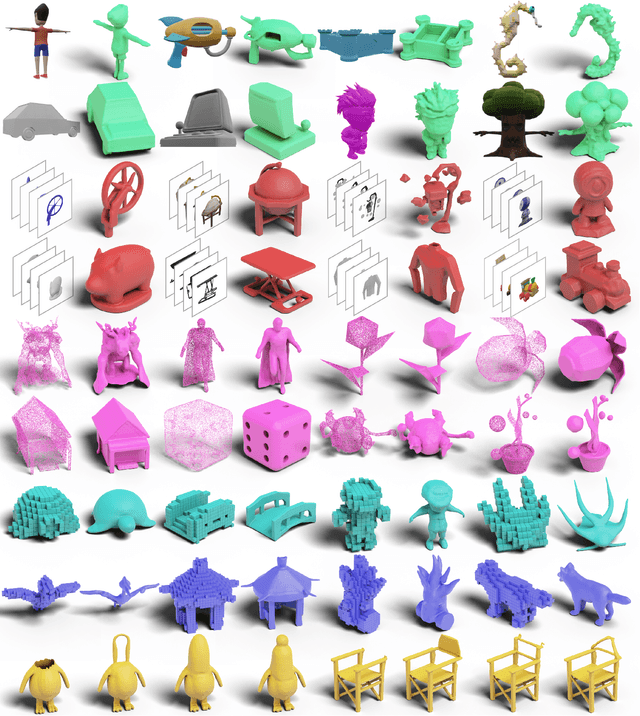
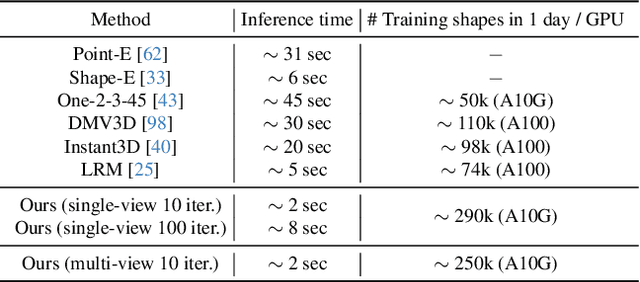
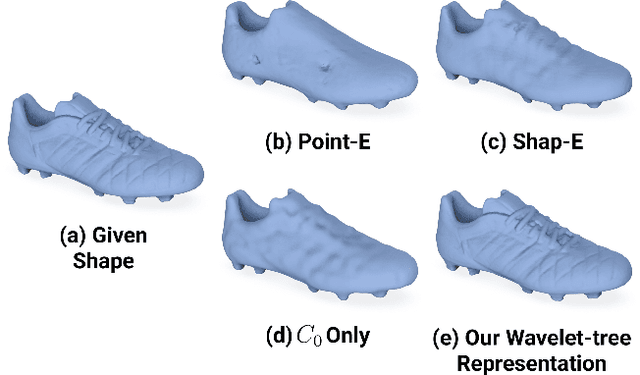
Abstract:Significant progress has been made in training large generative models for natural language and images. Yet, the advancement of 3D generative models is hindered by their substantial resource demands for training, along with inefficient, non-compact, and less expressive representations. This paper introduces Make-A-Shape, a new 3D generative model designed for efficient training on a vast scale, capable of utilizing 10 millions publicly-available shapes. Technical-wise, we first innovate a wavelet-tree representation to compactly encode shapes by formulating the subband coefficient filtering scheme to efficiently exploit coefficient relations. We then make the representation generatable by a diffusion model by devising the subband coefficients packing scheme to layout the representation in a low-resolution grid. Further, we derive the subband adaptive training strategy to train our model to effectively learn to generate coarse and detail wavelet coefficients. Last, we extend our framework to be controlled by additional input conditions to enable it to generate shapes from assorted modalities, e.g., single/multi-view images, point clouds, and low-resolution voxels. In our extensive set of experiments, we demonstrate various applications, such as unconditional generation, shape completion, and conditional generation on a wide range of modalities. Our approach not only surpasses the state of the art in delivering high-quality results but also efficiently generates shapes within a few seconds, often achieving this in just 2 seconds for most conditions.
EXIM: A Hybrid Explicit-Implicit Representation for Text-Guided 3D Shape Generation
Nov 03, 2023
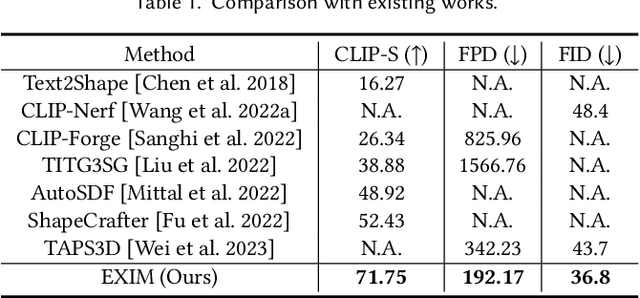


Abstract:This paper presents a new text-guided technique for generating 3D shapes. The technique leverages a hybrid 3D shape representation, namely EXIM, combining the strengths of explicit and implicit representations. Specifically, the explicit stage controls the topology of the generated 3D shapes and enables local modifications, whereas the implicit stage refines the shape and paints it with plausible colors. Also, the hybrid approach separates the shape and color and generates color conditioned on shape to ensure shape-color consistency. Unlike the existing state-of-the-art methods, we achieve high-fidelity shape generation from natural-language descriptions without the need for time-consuming per-shape optimization or reliance on human-annotated texts during training or test-time optimization. Further, we demonstrate the applicability of our approach to generate indoor scenes with consistent styles using text-induced 3D shapes. Through extensive experiments, we demonstrate the compelling quality of our results and the high coherency of our generated shapes with the input texts, surpassing the performance of existing methods by a significant margin. Codes and models are released at https://github.com/liuzhengzhe/EXIM.
Texture Generation on 3D Meshes with Point-UV Diffusion
Aug 21, 2023


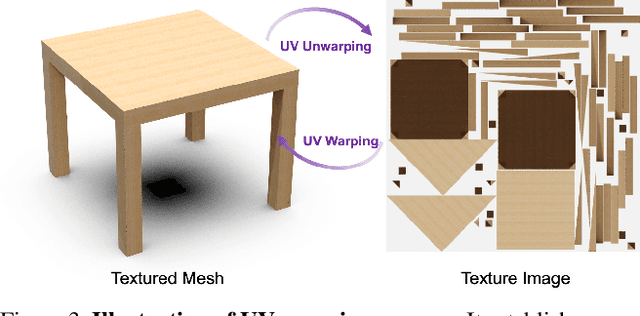
Abstract:In this work, we focus on synthesizing high-quality textures on 3D meshes. We present Point-UV diffusion, a coarse-to-fine pipeline that marries the denoising diffusion model with UV mapping to generate 3D consistent and high-quality texture images in UV space. We start with introducing a point diffusion model to synthesize low-frequency texture components with our tailored style guidance to tackle the biased color distribution. The derived coarse texture offers global consistency and serves as a condition for the subsequent UV diffusion stage, aiding in regularizing the model to generate a 3D consistent UV texture image. Then, a UV diffusion model with hybrid conditions is developed to enhance the texture fidelity in the 2D UV space. Our method can process meshes of any genus, generating diversified, geometry-compatible, and high-fidelity textures. Code is available at https://cvmi-lab.github.io/Point-UV-Diffusion
One Thing One Click++: Self-Training for Weakly Supervised 3D Scene Understanding
Mar 26, 2023



Abstract:3D scene understanding, e.g., point cloud semantic and instance segmentation, often requires large-scale annotated training data, but clearly, point-wise labels are too tedious to prepare. While some recent methods propose to train a 3D network with small percentages of point labels, we take the approach to an extreme and propose ``One Thing One Click,'' meaning that the annotator only needs to label one point per object. To leverage these extremely sparse labels in network training, we design a novel self-training approach, in which we iteratively conduct the training and label propagation, facilitated by a graph propagation module. Also, we adopt a relation network to generate the per-category prototype to enhance the pseudo label quality and guide the iterative training. Besides, our model can be compatible to 3D instance segmentation equipped with a point-clustering strategy. Experimental results on both ScanNet-v2 and S3DIS show that our self-training approach, with extremely-sparse annotations, outperforms all existing weakly supervised methods for 3D semantic and instance segmentation by a large margin, and our results are also comparable to those of the fully supervised counterparts. Codes and models are available at https://github.com/liuzhengzhe/One-Thing-One-Click.
 Add to Chrome
Add to Chrome Add to Firefox
Add to Firefox Add to Edge
Add to Edge